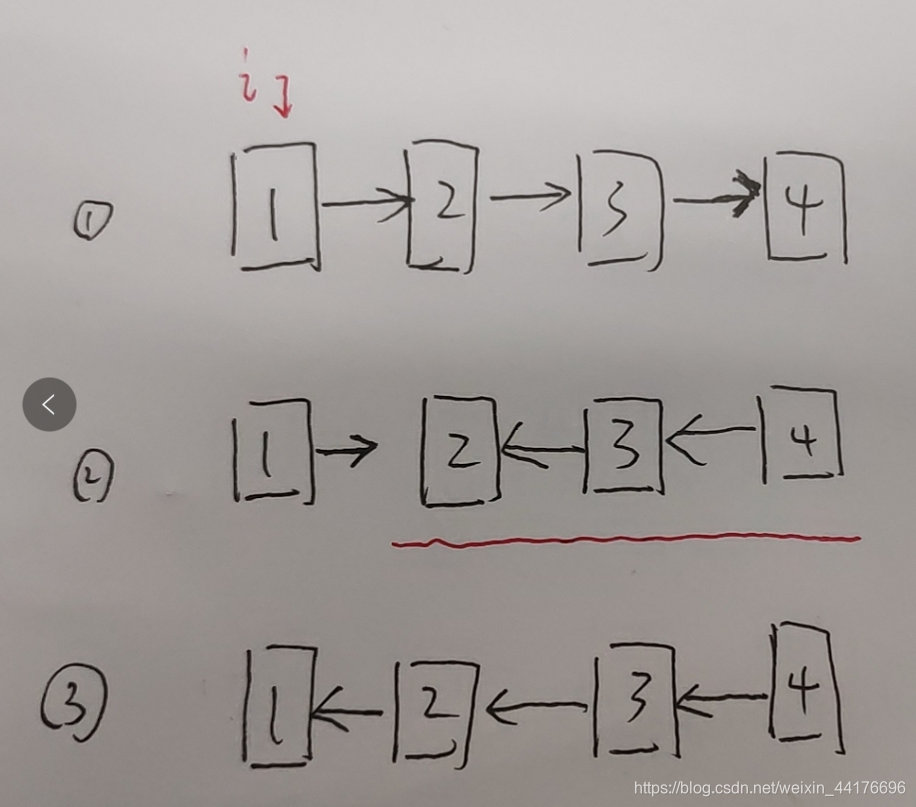链表翻转 递归与非递归写法
链表类实现:
class node
{
public:
node();
int data;
node* next;
void insert(int dt);
void display();
};
node::node()
{
this->next = NULL;
}
void node::insert(int dt)
{
node* nd = new node();
nd->data = dt;
node* p = this;
while(p->next)
{
p = p->next;
}
p->next = nd;
}
void node::display()
{
node* p = this->next;
while(p)
{
cout<<p->data<<" ";
p = p->next;
}
cout<<endl;
}
递归翻转:
- 要翻转第 i 个节点, 先翻转 i 之后的所有节点
- 然后将 第 i+1 个节点的 后继指针next 指向 第 i个节点
- 将 第 i 个节点的后继指针next 置空

/*
链表翻转递归写法
param p : 要翻转的链表的第一个元素的指针
return : 新表的第一个元素的指针
*/
node* flip(node* p)
{
// 如果p不是原表尾节点
if(p->next)
{
node* new_head = flip(p->next); // 翻转p的所有后继节点,获得新表的第一个元素
p->next->next = p; // p的后继的后继指向p
p->next = NULL; // p的后继置空
return new_head; // 返回新表第一个元素
}
// 如果p是原表尾节点,返回
else
{
return p;
}
}
非递归翻转
p1, p2做迭代指针
- 记录p2的后继节点,用temp保存
- p2的后继指针指向p1
- p1 = p2, p2 = temp,后向迭代

/*
链表翻转迭代写法
param p : 要翻转的链表的第一个元素的指针
return : 新表的第一个元素的指针
*/
node* flip_(node* t)
{
node* p1 = t;
node* p2 = t->next;
p1->next = NULL; // 尾节点是p1, p1->next置空
while(p2)
{
node* temp = p2->next; // 保存p2的下一个节点
p2->next = p1; // 修改p2的next,指向P1
p1 = p2; // p1, p2向后迭代
p2 = temp;
}
return p1;
}
主函数
int main()
{
int n, i, x;
cin>>n;
node* t;
for(i=0; i<n; i++)
{
cin>>x;
t->insert(x);
}
t->next = flip_(t->next);
t->display();
t->next = flip(t->next);
t->display();
return 0;
}
运行结果

完整代码
#include <iostream>
using namespace std;
class node
{
public:
node();
int data;
node* next;
void insert(int dt);
void display();
};
node::node()
{
this->next = NULL;
}
void node::insert(int dt)
{
node* nd = new node();
nd->data = dt;
node* p = this;
while(p->next)
{
p = p->next;
}
p->next = nd;
}
void node::display()
{
node* p = this->next;
while(p)
{
cout<<p->data<<" ";
p = p->next;
}
cout<<endl;
}
/*
链表翻转递归写法
param p : 要翻转的链表的第一个元素的指针
return : 新表的第一个元素的指针
*/
node* flip(node* p)
{
// 如果p不是原表尾节点
if(p->next)
{
node* new_head = flip(p->next); // 翻转p的所有后继节点,获得新表的第一个元素
p->next->next = p; // p的后继的后继指向p
p->next = NULL; // p的后继置空
return new_head; // 返回新表第一个元素
}
// 如果p是原表尾节点,返回
else
{
return p;
}
}
/*
链表翻转迭代写法
param p : 要翻转的链表的第一个元素的指针
return : 新表的第一个元素的指针
*/
node* flip_(node* t)
{
node* p1 = t;
node* p2 = t->next;
p1->next = NULL; // 尾节点是p1, p1->next置空
while(p2)
{
node* temp = p2->next; // 保存p2的下一个节点
p2->next = p1; // 修改p2的next,指向P1
p1 = p2; // p1, p2向后迭代
p2 = temp;
}
return p1;
}
int main()
{
int n, i, x;
cin>>n;
node* t;
for(i=0; i<n; i++)
{
cin>>x;
t->insert(x);
}
t->next = flip_(t->next);
t->display();
t->next = flip(t->next);
t->display();
return 0;
}
